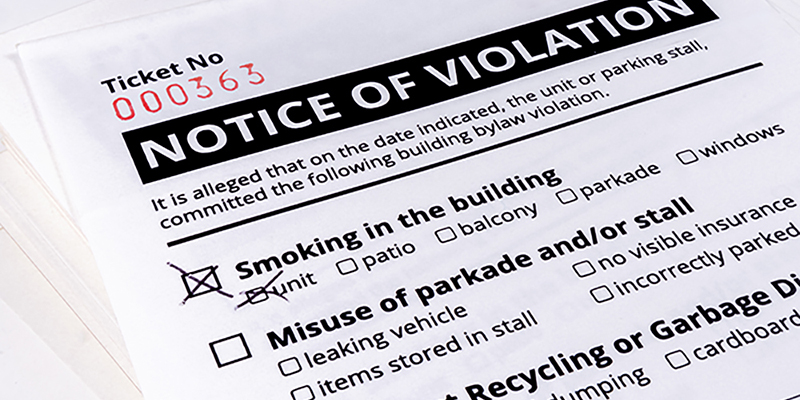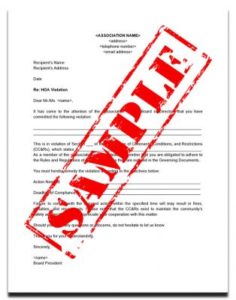How To Make An HOA Violation Letter

In every homeowners association, there will be homeowners who break the rules accidentally or intentionally. That’s why HOA boards must take non-compliance seriously. At the first sign of offense, they must send an HOA violation letter to remind a homeowner of his obligations to the HOA. If you want to improve rule enforcement, here’s a helpful guide for creating HOA violation letters.
Browse By Category
Sign up for Our Newsletter
In every homeowners association, there will be homeowners who break the rules accidentally or intentionally. That’s why HOA boards must take non-compliance seriously. At the first sign of offense, they must send an HOA violation letter to remind a homeowner of his obligations to the HOA. If you want to improve rule enforcement, here’s a helpful guide for creating HOA violation letters.
What Is the Purpose of an HOA Violation Letter?
Homeowners must sign a contract to join an HOA community. After this, they are legally obliged to follow the stipulations of the contract. This includes a set of rules and regulations set forth by the association. Compliance with these covenants is essential in creating a peaceful and harmonious community. HOA rules also serve to protect the interests of the community at large — including the preservation of property values.
Nevertheless, HOA communities still deal with non-compliance regularly. There are many homeowners who simply forget, but there are also others who make a conscious effort to bypass HOA rules. In both cases, HOA boards must make sure to enforce the covenants.
The purpose of an HOA violation notice is to inform homeowners of their non-compliance. The letter must include specific details about the purported offense, what homeowners can do to rectify the situation and a reasonable time frame for them to implement these changes. The contents of the HOA violation letter may also depend on your governing documents, as well as state and local laws.
How to Make an HOA Violation Letter: 7 Easy Steps
 The violation letter is an important document that all HOAs must have. Once you have an official template, it will be easier to follow up on HOA violations in your community.
The violation letter is an important document that all HOAs must have. Once you have an official template, it will be easier to follow up on HOA violations in your community.
Here are seven steps to follow when creating violation letters for your HOA community:
1. State the Purpose of the HOA Violation Letter
At the start, state your reason for issuing an HOA violation letter. Cite the specific section in your covenants that the homeowner has violated or not complied with. This helps establish the legitimacy of the HOA violation.
2. Provide Evidence of HOA Violation
Inform the homeowner that following a property inspection, they were found to have violated HOA rules and regulations. If possible, include pictures as evidence of the HOA violation.
3. Request for Necessary Changes
Indicate what changes the homeowner should make to resolve the violation.
4. Give a Reasonable Time Period for These Changes
Give homeowners enough time to make necessary changes to their property. Make sure the time period is appropriate considering the type of HOA violation. Some violations may only take a couple of days or weeks while more serious violations could require 30 days or longer.
5. Include Details of Disciplinary Hearing
All homeowners have a legal right to a disciplinary hearing before being penalized by their association. If homeowners want to contest their violation, they may do so during the hearing. With serious HOA violations, the board may also compel homeowners to attend the disciplinary hearing. They can learn additional details that will provide insight into what consequences an offending homeowner will receive.
6. Send HOA Violation Letter to Offending Homeowner
Consult your governing documents and state laws on the proper way of sending HOA violation letters. Some areas or communities may require HOA violation letters to be sent via registered mail or be personally delivered to the offending homeowner.
7. Follow Up with an HOA Warning Letter
If homeowners do not respond to the HOA violation letter or have not made the necessary changes to their property, the board should send a warning letter as a follow-up. The second violation letter can be more strongly worded to encourage compliance.
Meanwhile, in the final warning letter, you can inform the offending homeowner that their case will be sent to an HOA attorney or a collections company for further action. It should also include any fines or consequences that the homeowner has due to non-compliance.
Free HOA Violation Letter Template
As long as you follow the above-mentioned steps, it will be easy to create a violation letter for your HOA. If you need some inspiration, there are plenty of HOA violation letter templates available. Here is a free sample template from HOA Management (.com).

Click here to Download Your Free HOA Violation Letter
Additional Reminders for HOA Violation Letters
 As a board member, here are some other things to keep in mind when creating and sending your HOA violation letters:
As a board member, here are some other things to keep in mind when creating and sending your HOA violation letters:
- Covenant enforcement should be fair and uniform. Make sure to follow the same process for everyone. Selective enforcement will only encourage homeowners to break the rules. It may even lead to discrimination cases and other liabilities for the HOA.
- Ensure that your HOA violation letter is complete. Include details and pictures as much as possible. This lessens the chance that a homeowner will dispute the violation.
- Homeowners have a legal right to a disciplinary hearing and appeals process. Make sure to have these proceedings before the HOA board issues a final verdict.
- Try to resolve HOA disputes arising from violations within the community. If the matter is taken to court, both the HOA and homeowner will end up spending a lot of time, money, and energy. These disputes may also strain relationships in your community.
Solidify Your Covenant Enforcement Process with an HOA Violation Letter
In order to create a peaceful and harmonious community, everyone must do their part. Homeowners must follow the rules and regulations. Meanwhile, the HOA board must ensure that all members are complying with these covenants.
Enforcing rules is difficult so it’s important to have an established process — which usually begins with an HOA violation letter. As long as you have these steps in place, HOA boards will find covenants enforcement much more manageable.
RELATED ARTICLES:
- A Complete Overview of HOA Board Duties
- What Is A Covenants Committee? What Does It Do Exactly?
- 6 Tips On How Can HOA Enforce Rules And Regulations
Trending Now
Related Article
Sign up for Our Monthly Newsletter
Sign up below for monthly updates on all HOA Resource
















